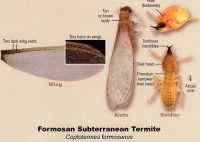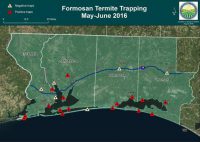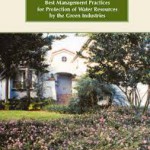by Julie McConnell | Feb 23, 2017
Please check out our Upcoming Events page to see what classes are offered in the Panhandle for Green Industry Professionals.
If you’d like to have emails about upcoming events sent directly to your inbox, sign up for our newsletter at Subscribe UF/IFAS select “Green Industries in the Panhandle” under the “Lawn & Garden” tab.
by Sheila Dunning | Aug 26, 2016
 The genus Coptotermes contains the largest number of termite pests (28 species) worldwide, with the Formosan subterranean termite, Coptotermes formosansus, being the most widely distributed and most economically important. During the 1960’s it was found in Texas, Louisiana, and South Carolina. The first well-established colony in Florida was reported in 1980.
The genus Coptotermes contains the largest number of termite pests (28 species) worldwide, with the Formosan subterranean termite, Coptotermes formosansus, being the most widely distributed and most economically important. During the 1960’s it was found in Texas, Louisiana, and South Carolina. The first well-established colony in Florida was reported in 1980.
A single colony of Formosan subterranean termite may contain several million termites that forage up to 300 feet in soil. Once established, the Formosan subterranean termite has never been eradicated from an area. Therefore, monitoring of movement of the species is critical. Beginning in 2015, the Florida Department of Agriculture of Consumer Science (FDACS) began trapping the alates. Termites have three primary castes: the reproductive, soldiers, and workers. Within the reproductive caste, the young females, referred to as alates, are the ones that leave the colony. They are able to form wings and seek new areas to become established. Dispersal flights or “swarms” are massive and begin at dusk on calm and humid evenings from April to July. Alates are attracted to lights.
The objective of the FDACS Formosan Termite Alate project is to trap alates throughout the four most western counties of the Panhandle during their major swarm season in May and June, which is the time they are most active in that part of Florida. Trapped alates were counted on a weekly basis to determine peak swarming weeks. White, gridded 7”x 4” sticky card attached to 6’ stakes are placed under strong, predetermined street lights. Twenty-two trap locations were selected, each representing a key Panhandle community with at least one location North of I-10 within each of the four counties.
In 2016, sixteen out of the 22 traps were positive for Formosan termite alates throughout the four Panhandle counties. Formosan alates were caught during 7 of the 8 weeks of trapping. The largest spike in numbers trapped was during the week of May 8th. A subsequent swarming spike occurred during the week of May 22nd. Trap locations that were positive in 2016 and not 2015 included Pensacola Beach, Destin, Blue Mountain Beach, Okaloosa Island and Choctaw Beach. The project will be continued each year in order to determine some of the problem areas.
For more information go to:
by Sheila Dunning | Mar 24, 2016
 On June 18, 2009, Florida Governor Charlie Crist signed into law SB 494 requiring all commercial fertilizer applicators have a license by January 1, 2014. Passing the Green Industries Best Management Practices (GI-BMP) training is mandatory to obtain that license. University of Florida/IFAS Extension provides training and testing programs in urban landscape management practices and issues certificates demonstrating satisfactory completion of the training. These classes are available in English, Spanish, or Haitian Creole.
On June 18, 2009, Florida Governor Charlie Crist signed into law SB 494 requiring all commercial fertilizer applicators have a license by January 1, 2014. Passing the Green Industries Best Management Practices (GI-BMP) training is mandatory to obtain that license. University of Florida/IFAS Extension provides training and testing programs in urban landscape management practices and issues certificates demonstrating satisfactory completion of the training. These classes are available in English, Spanish, or Haitian Creole.
After receiving a certificate of completion of the GI-BMP training, a person must pay $25 and apply with Florida Department of Agriculture and Consumer Services (FDACS) to receive the Limited Certification for Urban Landscape Commercial Fertilizer (LCULCF) also commonly called the “fertilizer license.” You can apply online or download the paper application and apply by mail.
There has been a lot of confusion over which certificate is needed by the applicator. Many individuals have not completed the second step of the process and are not in compliance with current state laws. If you are unsure which certification you hold, check your wallet card for the identification number; an FDACS issued certification will begin with “LF” and the GI-BMP certification begins with “GV.” You must have the FDACS certification beginning with “LF” to apply fertilizer for-hire.
The LCULCF certification expires 4 years after the date of issuance. Continuing education of two hours of F.S. 482 General Standards CORE and two hours of the category Limited Urban Fertilizer are required for renewal. Those that received their LCULCF certification before the 2014 deadline may be approaching the need for renewal.
The good news is, if you passed the GI-BMP certification but failed to take the next step towards FDACS certification your GI-BMP training certificate is non-expiring and you can still apply for the LCULCF without attending the training again. Not sure if you have successfully completed this program? You can check here the list of certificate holders by county at http://ffl.ifas.ufl.edu/professionals/certification_lists/cert_county_name.shtml.
If you did pass the course, but cannot locate your GI-BMP certificate, you can request a replacement copy here.
Using UF/IFAS-recommended application rates and timing of pesticides, fertilizer and irrigation can help prevent nonpoint source pollution (water pollution that is associated with everyday human activities and driven by rainfall, runoff and leaching) from urban landscapes. By choosing plants appropriate for the site and maintaining them with correct cultural practices (irrigation, fertilization, mowing and pruning), one can significantly reduce the amount of water a landscape needs to thrive.
The GI-BMP class teaches landscape workers how to implement these Best Management Practices into their daily work. This is an opportunity for Green Industry workers to complete this requirement and market their skills to clientele. Trainings are available monthly across the Panhandle as well as on-line. Visit the website for more information http://fyn.ifas.ufl.edu/professionals/BMP_overview.htm.
 The genus Coptotermes contains the largest number of termite pests (28 species) worldwide, with the Formosan subterranean termite, Coptotermes formosansus, being the most widely distributed and most economically important. During the 1960’s it was found in Texas, Louisiana, and South Carolina. The first well-established colony in Florida was reported in 1980.
The genus Coptotermes contains the largest number of termite pests (28 species) worldwide, with the Formosan subterranean termite, Coptotermes formosansus, being the most widely distributed and most economically important. During the 1960’s it was found in Texas, Louisiana, and South Carolina. The first well-established colony in Florida was reported in 1980.
 On June 18, 2009, Florida Governor Charlie Crist signed into law SB 494 requiring all commercial fertilizer applicators have a license by January 1, 2014. Passing the Green Industries Best Management Practices (GI-BMP) training is mandatory to obtain that license. University of Florida/IFAS Extension provides training and testing programs in urban landscape management practices and issues certificates demonstrating satisfactory completion of the training. These classes are available in English, Spanish, or Haitian Creole.
On June 18, 2009, Florida Governor Charlie Crist signed into law SB 494 requiring all commercial fertilizer applicators have a license by January 1, 2014. Passing the Green Industries Best Management Practices (GI-BMP) training is mandatory to obtain that license. University of Florida/IFAS Extension provides training and testing programs in urban landscape management practices and issues certificates demonstrating satisfactory completion of the training. These classes are available in English, Spanish, or Haitian Creole.